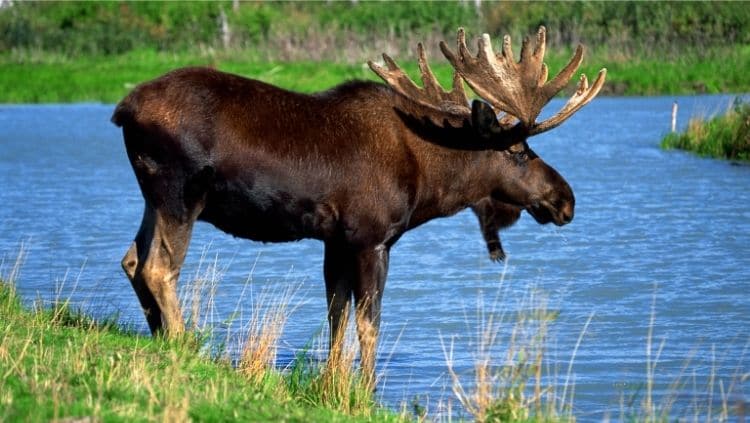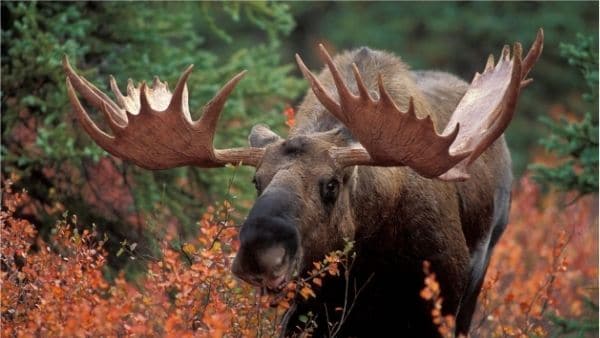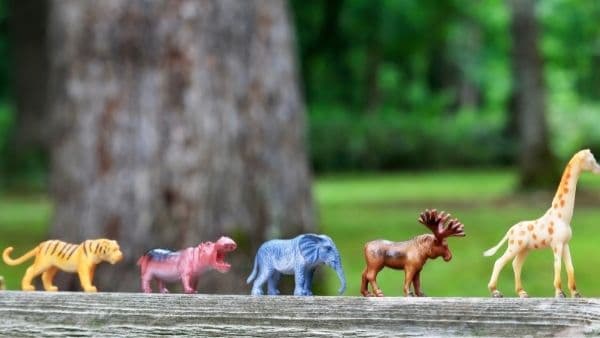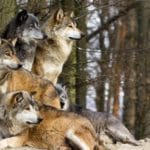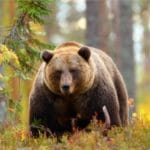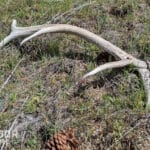Moose are magnificent creatures. Their long slender legs prop up a massive body with a hump to boot. They may look awkward, but they are super nimble, fast, and even skilled swimmers. They are among the largest ungulates (cloven-hoofed animals) in the world. But how big are moose?
We all know that these are big animals. But just knowing they are large will not help you win a bet or get that trivia question right. You need to know some more detailed figures like average weight, height and length, right?!
An average bull moose weighs 1,100 pounds, is 6 feet tall at the shoulder, and is 8.5 feet long. Males are generally 40% larger than females, and Alaskan moose are 30% larger than other subspecies. Moose are the largest members of the deer family and the second largest land animal in North America.
If you really want to properly insult your buddy by claiming a moose is bigger than his new eco-friendly compact pickup, read on so you can get your facts straight.
How Big is a Full Size Moose?
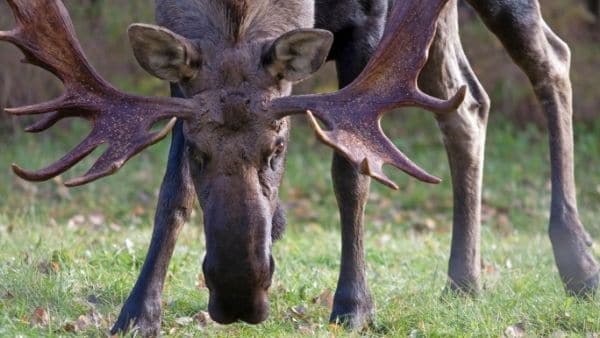
Moose are the largest land mammals in Europe and the second largest in North America. Only the American Bison is bigger.
Relatively small parts of a moose are their feet and tail. Their hooves are only about 5 inches (13cm) wide and their toes 7 inches (18cm) long. Their tails are less than 5 inches (12cm) long. However, their bell (the long beard-like thing that hangs from their neck) can be up to 20 inches (50cm) long on a bull!
Average Weight
Bull moose (males) range in weight from 600-1,700 pounds (270-770kg). The typical range of mature male is between 900-1,300 pounds (405-590kg) in most of the world, with an average weight of 1,100 pounds (500kg). Bulls usually weigh 40% more than cows (females).
Cow moose (females) range from 500-1,000 pounds (225-450kg) though the typical weight falls between 600-800 pounds (270-360kg). An average female weighs 700 pounds (320kg).
The birth weight of a moose is usually between 20-35 pounds (9-16kg) with an average of about 25 pounds (11kg). Calves are born in the spring and then grow to 300-400 pounds (135-180kg) by the subsequent fall. That’s a toddler who gains about 16 times their birth weight in six months!
Within four to six years, moose will be fully grown. Mature moose reach their peak weight at around 10 years of age.
An adult moose eats 50 pounds (23kg) or more of forage and aquatic plants per day to sustain that kind of weight. They can hold about 100 pounds (46kg) of food in their stomach at any given time!
Average Height
Like most 4-legged animals, moose height is measured at the top of the shoulder. Large bulls average a height of 6 feet (1.8m) at the shoulder but can surpass 7 feet (2.1m). Cows come in a bit shorter and fall within the typical height range of 4.5-6 feet (1.4-1.8m).
While moose typically hold their head at a height in line with their shoulder (they eat off the ground, after all), their head and antlers will clearly add some elevation when they are on alert with their head raised. This significantly adds to their apparent height, making them seem 8-11 feet (2.4-3.4m) tall.
A typical house in the US has a ceiling height of 8 feet from the floor. So you could possibly invite a cow moose in for dinner, but a bull with antlers? Forget about it, unless you have some serious vaulted ceilings, or they just hang out in the garage!
Moose are lanky creatures with long legs and a high center of mass. This is what makes them so dangerous for drivers. Their legs are usually taller than the hoods of most cars, so when you hit one, it just slips the legs out from under it. Then the massive body lands right on your windshield or roof. The animal and the people involved in a collision do not always survive.
Average Length
The length of a moose from the tip of the nose to the tail is approximately the same as the width of a single lane of a typical road. From 7.5 to more than 10 feet long (2.3-3.1m), if one is crossing the street in your lane, he will be taking up the entire lane!
Bull moose range from 6.6 to over 10 feet (2.4-3.1m) long with an average length of 8.5 feet (2.4m), the same as a Smart car (ForTwo). Females range 6.5 to 9.8 feet (2.3-3.0m) in length with an average of about 7.5 feet (2.1m).
Related: How Big Are Wolves: Variation, Record & Wolf Size Comparison
How Big are a Moose’s Antlers?
On smaller subspecies, average bull moose antlers can measure as much as 4-5 feet wide and weigh 25-30 pounds. However, a big Alaskan bull’s rack can be 6.5 feet wide and weigh 80 pounds!
Only male moose carry antlers, which are essentially bone material. They grow them every year in the spring and summer, adding as much as a pound of bone and an inch in length every day. They shed their antlers in the winter after mating season.
Moose antlers grow back larger each year, typically reaching their maximum size on bull between 10 and 12 years old, if they live that long.
Moose Size Comparison to Other Large Animals
So how do moose compare in size to other beasts of the field and village?
This is where you really start to build your arsenal of inconsequential knowledge that will serve you very well in winning useless arguments and trivia games.
Let’s do a face-off round!
1. How big is a moose compared to a horse?
Weighing between 800-1,300 pounds (360-600kg), an average horse weighs similar to an average moose. However, the latter are notably taller at around 6 feet (1.8m) tall than horses at just over 5 feet (1.5m) tall. The largest draft horses can weigh a metric ton and reach 6 feet tall at the withers, but an Alaskan moose will have him beat on height, especially once you add those antlers.
Moose wins.
2. How big is a moose compared to an elephant?
It’s no secret that elephants are the largest land animals on Earth today. The smallest elephants, African Forest elephants, are about as tall as the biggest Alaskan moose at around 7 feet (2.1m) at the shoulder, but they weigh an average of more than 4,000 pounds (1.8t). African Bush elephants are the largest and can weigh 3 times that! There’s really no competition here.
Elephant wins.
3. How big is a moose compared to an elk?
Elk are often similar in length from head to tail, but moose are simply more massive. At an average of 4 ft (1.2m) tall, elk weighing between 400 and 1,100 pounds (180-500kg), elk are about a third smaller than a moose. Even the largest bull Roosevelt Elk on record would only be about the size of an average bull Alaskan Moose.
Moose wins.
4. How big is a moose compared to a bison?
The American Bison sits upon the throne for the largest land animal in North America. They reach about the same height as a big moose but are 40% longer and can weigh twice as much. At 11.5 feet (3.3m) long and weighing 880 to 2,800 pounds (400-1,270kg), mature bison are as big as a compact car.
Bison wins.
5. How big is a moose compared to a human?
In the US, the average woman is 5 feet 4 inches (163cm) tall and 170 pounds (77kg), whereas the average man is 5 feet 9 inches (175cm) tall and weighs 200 pounds (91kg). So the average human is shorter than the average moose at the shoulder by about half a foot. A moose weighs about as much as 4 to 8 humans put together.
Moose wins. Duh.
6. How big is a moose compared to a car?
It depends on the car, as you might imagine. A Mini Cooper weighs about 2,700 pounds (1,225kg), is 12.7 feet (3.8m) long, and 4.7 feet (1.4m) tall. So a big bull moose weighs about half as much and is about 4 feet shorter than a Mini Cooper, but it stands a couple of feet taller. I guess cars are bigger, but in a collision, no one wins.
We’ll call it a draw.
As a bonus for Christmas fans, a reindeer is about the size of a toddler moose.
With that, we can conclude that moose are very large animals, especially in North America. But there are still bigger things out there, so they do not trump all.
Related: Largest Bear Ever and 8 Biggest Bear Species in the World
Subspecies and Size Variations
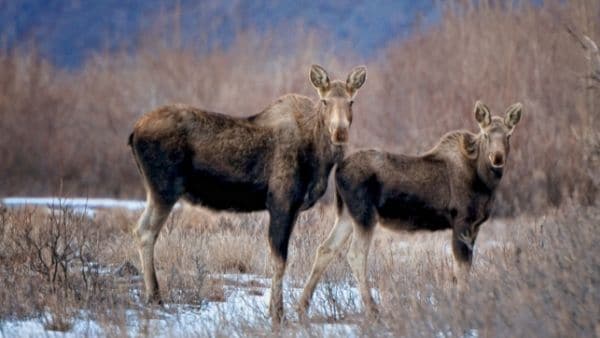
The average size and weight of moose can vary based on region and subspecies.
Moose are found most abundantly in North America, namely the United States and Canada. This region has four subspecies, including eastern, western, Shiras (Yellowstone), and Alaskan.
The Alaska-Yukon moose (Alces alces gigas) is the largest of all subspecies and is typically about 30% larger than other moose. These beasts are found primarily in Alaska and Western Canada, including the Yukon Territory.
A large Alaskan bull moose can weigh 1,600 pounds and be over 6 feet tall. Whereas a large bull from the lower 48 might weigh in at around 1,200 pounds. A typical Alaskan cow weighs about 1,000 pounds, and even a small female can weigh 800 pounds. This would be considered average or even large in other regions.
The Shiras moose (a.k.a. Yellowstone, Wyoming, Alces alces shirasi) is found throughout the Rocky Mountain region in the Western United States. It is the smallest subspecies in North America, averaging less than 800 pounds when fully grown.
Moose are also quite numerous in forested areas throughout Russia and Northern Europe. They are usually referred to as Eurasian Elk or simply elk in these regions. There are four subspecies here, including European, Yakutia, Ussuri, and Chukotka. Chukotka elk is found in Eastern Siberia and is the largest Eurasian Elk, while Ussuri is the smallest subspecies of moose worldwide.
World Record Moose
According to the Guinness Book of World Records, the largest moose ever officially recorded was an Alaskan bull harvested by a hunter in 1897 in the Western Yukon Territory. It weighed 1,808 pounds (820kg) and measured 7.6 feet tall (2.3m).
That’s the same weight as about 45 bales of hay and taller than a garage door.
Can you imagine that guy with his head raised and fully grown antlers?! He must have stood nearly as tall as a house!
The biggest moose recorded by the Boone and Crockett Club was harvested in 2010 by a hunter on the Lower Yukon River in Alaska. It scored a 266 4/8, which means it had ginormous antlers around 80 inches wide.
There are surely hunters with tales of even larger moose roaming the woods. No matter how you look at it, these are remarkable giant creatures that are worth our conservation efforts to ensure they thrive forever.
Sources:
- Alaska Department of Fish and Game
- New York State Department of Environmental Conservation
- Animal Diversity Web, University of Michigan Museum of Zoology
- Maine Department of Inland Fisheries and Wildlife
- AZ Animals
- Wikipedia

